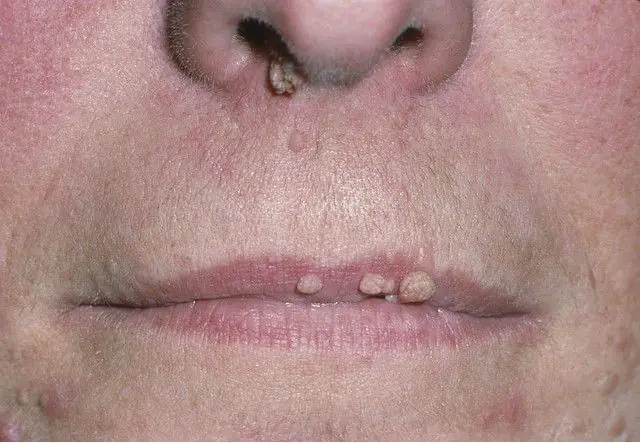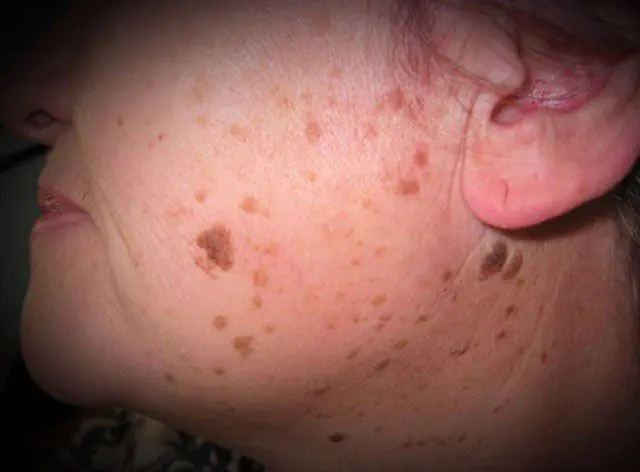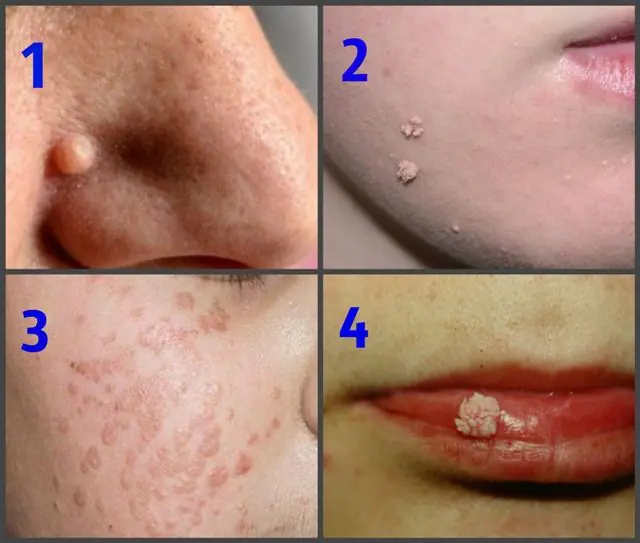
- Sizes of papillomas on the face
- Main types
- Localization
Papilloma on the face is a small tumor that appears as a lump or spot, depending on the type of formation. They differ from each other in size, color, surface, shape and many other parameters. In medicine, there are only five of them, and the appearance of each of them causes the activity of one or another type of HPV.
Sizes of papillomas on the face

In the photo there are papillomas on the face
Different types of papillomas can appear on the face - both small and large; the higher the activity of the virus, the faster the formation grows. On average, their size reaches 0.5 cm, although there are cases when they reach 1 cm.
The peculiarity of these growths is that they quite often merge into one group if 2-5 pieces appear. near. In this case, it is difficult to clearly determine their boundaries, width and length.
Smallest in size flat papillomas on the face, which almost do not protrude above the skin, but they can “migrate” to neighboring areas, thereby increasing the affected area. These neoplasms are not tall, but at the same time they are quite long, unlike hanging ones, on a stalk.
In the case of the latter, things are completely different, hanging papillomas practically do not come into contact with tissues, but grow mainly in height.
More often simple papillomas appear on the eyelids, near the lips and nose, and flat ones can be located in absolutely any area. Naturally, this type of papillomas on the face is more striking, since the growths stand out sharply against the general background.
At the very beginning, papilloma is just a point, barely noticeable to others. If there is no reaction to its appearance, it begins to gradually or sharply increase in size. Over time, the growth reaches a large diameter and is difficult to ignore. In the absence of treatment, there is every reason for its growth to continue; there are no limits here. The faster cells break down and divide, the faster this process occurs.
Main types of papillomas on the face

In the photo there are types of papillomas on the face
There are five types of facial papillomas: simple, filiform, flat, genital warts and plantar warts. It is on the face that only 2-3 types appear, mostly hanging and ordinary formations. There are situations when they accompany each other and appear on the skin at the same time.
Let's describe each type of papilloma:
- Simple. In another way, they are often called vulgar; they grow on the skin due to the impact of papillomavirus types 2 or 4 on the body. Externally, this type of papillomas on the face, when looking at the photo, looks like warts, resembling hard round bumps. Usually their color is flesh-colored, due to which they do not stand out very much from the background of surrounding tissues. The diameter of such growths is no more than 0.4 cm, their surface is rough and rough. First, dark dots appear in their place, which after some time give way to papules, and then a crust forms. Such tumors are benign and have a low probability of becoming malignant. They are distinguished from other types of papillomas by the formation of groups of 3-5 pieces. To remove such tumors, completely different methods are used - laser therapy, cryodestruction, electrocoagulation.
- Filiform. Looking at a photo of this type of papilloma on the face, you can see that it is a small warty formation, shaped like a cone. It always grows upward, rising several centimeters above the skin. As this happens, the growth narrows and reaches its minimum width at its end. It has a well-developed root that is difficult to remove. It goes deep into the tissue and helps the tumor stay on the surface. Closer to the base, such a formation has a more saturated color than at the top, where it is usually beige or flesh-colored. Quite often, in photos and videos of papillomas on the face, you can see how the growth is divided into several parts and looks as if it has just burst. If an infection penetrates inside, its edge may turn black, which will require an urgent response from the person. Its standard size is up to 1 cm, possible locations are on the nose, on the lower or upper eyelid, near the lips, next to the eyes, closer to the chin. Education occurs as a result of the active activity of virus types 3, 5, 8 and 9.
- Flat. The name of such papillomas speaks for itself: they almost completely merge with the skin, which creates some difficulties in determining their difference from birthmarks and moles. The peculiarity of these growths is that they are located in groups, sometimes their number reaches 10 pieces. and even more. It happens that they are confused with burn marks and with manifestations of various dermatological diseases. In the photo, this type of papilloma on the face has a beige, pale pink or light brown tint. Their size is about 6 mm, but can be larger. The most common places for their location are around the mouth, especially in the corners. If the surface is damaged, its redness, mild swelling and itching may occur. Scratching the skin leads to bleeding and discomfort. Papillomavirus types 3 or 10 are to blame for such problems; only one of them provokes their appearance.
- Pointed. Such papillomas are called condylomas; they usually grow on the mucous membranes of the genital organs. But in some cases they make themselves felt on the face, especially in the areas surrounding the eyes. The reason for their appearance may be the use of someone else's razor and cosmetics from an infected person, or the performance of cosmetic procedures with poorly sterilized instruments. Their diagnosis is the easiest, since this type of papilloma on the face, when studying a photo of an infected person, looks like cauliflower. It has the same uneven surface with a rough finish, rough edges and an untidy shape. The color of genital warts can be beige, pink, pale brown, or flesh-colored. Their size usually does not exceed 1 cm; in rare cases, formations with a larger diameter can be seen. The catalyst for the appearance of such growths is a virus of type 6, 11 or 16. These neoplasms are the most dangerous among all existing ones, because if you do not pay attention to themselves, they can degenerate into malignant tumors and begin to actively grow.
Localization of papillomas on the face

The most “favorite” localization zones for such growths are upper and lower eyelids. They can be located right at the junction of the eyelashes and the skin, which creates certain difficulties when trying to close or open the eyes. The problem here also lies in the fact that not every method of removing papilloma can be used without consequences.
Often, various types of papillomas on the face are concentrated near the mouth, creating a large area of rash.
In addition, neoplasms can grow directly on the nose or among the eyebrows.
This happens less often on the forehead and cheeks, although these places are not protected. But if such formations do arise here, then mostly this happens in a single copy.
- Related article: Which doctor should I contact for papillomas?



